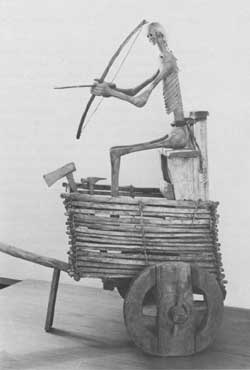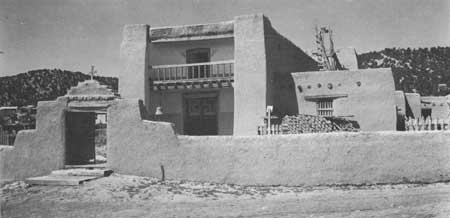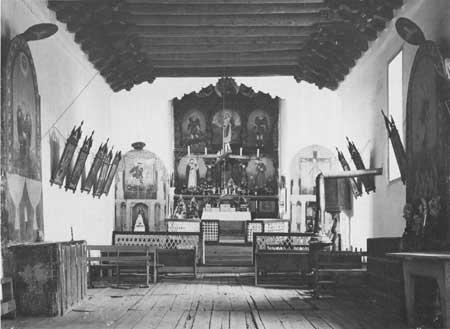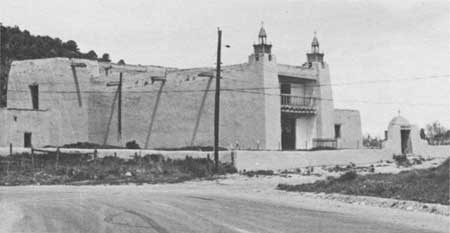

|
Las Trampas In the opinion of at least one devoted authority on historic architecture, the small Hispanic mountain community of Las Trampas on the high road to Taos possesses "the most perfectly preserved Spanish Colonial church in the United States." The structure, whose advocate is San José de Gracia, has survived in the twentieth century as much in spite of the people who live here as because of them. In 1776 Domínguez said they were a ragged and jovial lot, "as festive as they are poor, and very merry." Their settlement, Santo Tomás Apóstol del Río de las Trampas, dated from 1751 when Governor Tomás Vélez Cachupín, negotiating trade relations with the Comanches at the time, granted this exposed valley to twelve Hispano families. The number twelve later gave rise to the pretty but wholly unfounded story that a church of the Twelve Apostles laid up in the twelve years between 1580 and 1592 was erected here by twelve devoted men who were the only ones allowed to work on it. In reality Bishop Pedro Tamarón, passing through in 1760, left a license for the people to build inside their fortified plaza a church 30 varas long, including transept, "with the title and advocation of Lord St. Joseph of Grace and of Most Holy Mary Immaculate." He noted at the time that Las Trampas lay 2 leagues from Picurís over "an enemy-infested road." To raise alms, they went begging, especially the sprightly eighty-some-year-old patriarch of the community, Juan de Argüello. They cannot have collected much, but eventually they built their church. Fray Andrés de Claramonte, who served at neighboring Picurís in 1764-65 and again from 1770 to 1776, blessed the structure in accordance with the bishop's instructions. When wizened Argüello, who was said to have lived to 112, tried to wring some alms from Father Domínguez for sacred necessities, the friar pleaded Franciscan poverty and "gave him that with many thanks for his devotion." [1] In 1818 the Franciscan at Picurís was still seeing to the spiritual needs of Las Trampas, albeit unsatisfactorily, reported Juan Bautista Guevara. The Durango visitor's inventory began, "First the church, which is composed of transept, choir loft, baptistery, two towers, and a large door with iron lock and key." An image in the round of St. Joseph, identified in the twentieth century as the work of Bernardo de Miera y Pacheco, had yielded its central position to the Immaculate Conception, and a wooden altar screen, painted perhaps by the noted santero Pedro Fresquis, now rose to fill the entire wall above the altar. By the 1860s the screen needed repainting. José González, a displaced native of Sonora, did the job "in his coarse folk style" before moving on to work on a railroad gang in Colorado. His figures still stare out from their panels with reddish brown eyes. [2] In 1881 Lieutenant Bourke thought they should be burned, although he himself would have been the last to light a match. It was just this sort of "picturesque mediaevalism," in his view, that gave New Mexico its charm for the traveler. At Las Trampas the Philadelphian secured as his guide the ancient "Nestor of the place," who happened by on his burro.
The sketch Bourke termed hasty and imperfect was actually one of his best. The Trampas church appeared in good repair in 1881. Both projecting bell towers rose well above roof level to form belfries, each with four ample windows and pyramid roof. Surmounting the pyramids and the peaked pediment between, stood ornate wrought-iron crosses like the ones at Santa Cruz. Trampas boasted not one but two balconies. The first, with its latticework balustrade, crossed between the bell towers just above the front door. The second, with close-set vertical balusters, made a roof over the first and permitted a bell ringer to crawl out the window of one belfry and trot across to the other.
Because it cost too much to haul sheets of corrugated iron roofing up the steep and winding road to Las Trampas, the church of San José never suffered a peaked roof. Here economics and preservation coincided. In 1921, when the Rev. Peter Kuppers of Peñasco parish, a priest with an unusual appreciation of local tradition, asked the Museum of New Mexico for advice on how best to repair the leaking roof at Las Trampas, a team arrived almost overnight. "Where it would cost $1,000 or $1,200 to put on a disfiguring iron roof, it was found that the balcony and bell-tower could be restored to their original form and a tar and gravel roof good for twenty years, put on for approximately a quarter of that amount." But other good works of the Committee for the Preservation and Restoration of the New Mexican Mission Churches took precedence. For a decade Las Trampas had to wait. Finally one October day in 1931 the church bell rang out calling the people to a village meeting. Father Kuppers was there. So were some Anglos from Santa Fe: Mr. and Mrs. Daniel T. Kelly, Mr. and Mrs. Carlos Vierra, and B. A. Reuter, who had supervised the restorations at Ácoma and Santa Ana. They wanted to restore the Las Trampas church. They would supply the money for materials and the services of Mr. Reuter. In turn the village would have to provide laborers, teams of animals, rock, lumber, and logs. Father Kuppers "made a stirring talk" in favor. The people agreed. Later that fall and early the following spring, in the face of unusually heavy snows and flagging cooperation, the heroic Reuter kept at it. Three-layer felt and asphalt roof, remodeled drainage, rebuilt tower bases, new balcony beams, and new windows put the structure in shape to survive. The cost came to $1,175.37. A small price to pay even in the Depression, agreed the preservationists, who now looked upon the historic church of Las Trampas as a sacred trust. [4] A threat suddenly arose in 1966. The State Highway Department resolved to widen and pave New Mexico 76 right through Las Trampas. The improved, all-weather road would cut across the walled churchyard and pass within a few feet of the church itself. An article in The New Mexican sounded the alarm. Santa Fe preservationists, led by outspoken architect John P. Conron and by David J. Jones of the National Park Service, rallied for a fight. On the national scene, Nathaniel Alexander Owings, member of the Advisory Board on National Parks, Historic Sites, Buildings and Monuments and frequent picnicker on a hill above the New Mexico village, proclaimed that he would do what he could "to help preserve that which meant so much to me spiritually and professionally. It was the American aesthetic!" He had a dream, something beyond saving the church, something a little akin to playing God. "My dream," he wrote in his autobiography, "was to project a way of life in the village based on the economy of the 1800s when the villagers raised sheep, sheared the wool, spun it into yarn, wove the yarn into homespuns and rugs and used or sold the products." Dreams aside, Owings persuaded Secretary of the Interior Stewart L. Udall to write Governor Jack M. Campbell requesting a delay of the highway project. The governor consented, and the Southwest Region of the National Park Service went to work documenting the national significance of Las Trampas. The people of the village, meanwhile, protested. They wanted the road and whatever economic benefits might come with it. The old church be damned. More determined than ever to save the people of Las Trampas from themselves, the preservationists incorporated the Las Trampas Foundation and promptly applied for the protected status of National Historic Landmark. When that was granted in the spring of 1967, harm to the old earth-walled church became a federal offense. To the horror of the state highway people, National Landmark status also froze needed federal funds pending compliance with the National Historic Preservation Act of 1966.
Eagerly now, members of the State Highway Department got together in Santa Fe with officials of the U.S. Department of Transportation, the Bureau of Public Roads, and the National Park Service to hear what the Las Trampas Foundation had to say. Out of this meeting came the Treaty of Santa Fe, dated June 8, 1967, a brief seven-point compromise that John Conron considered about a 75-percent victory for the preservationists. Owings summed it up in these words:
To win over the old man and his neighbors, the Las Trampas Foundation, to which Owings had donated $10,000 toward preservation of the church, now offered to pay for a restoration, general repairs, and a fresh coat of mud plaster. The people, after the requisite meetings in the schoolhouse, accepted. The Foundation hired David J. Jones, National Park Service Resource Planner, to oversee the work in the summer of 1967. The ritual of the women mud-plastering the walls sent Owings into ecstasy. "The surface was almost as hard as glass with a texture like homemade bread crust, and the entirety so beautiful, so aesthetically satisfying, that the question of a cement surface was too ugly to consider." An old photograph showing wooden superstructures on both towers emboldened the internationally famous architect to reach for the "original appearance." John Gaw Meem designed the replacements "and thus forestalled any possible criticism as to their authenticity."
When all the work was done, the Rev. Casimiro Roca, who had sought throughout to reconcile villagers and preservationists, celebrated his twenty-fifth anniversary Mass in the renovated church at Las Trampas. Nearly every one turned out. "After the services," wrote Owings with justifiable pride, "all thirty-five members of the village joined us at the school house for cake and coffee—the cake baked in the exact form and detail of the church with everything edible except the ladder to the roof." [5]
Copyright © 1980 by the University of New Mexico Press. All rights reserved. Material from this edition published for the Cultural Properties Review Committee by the University of New Mexico Press may not be reproduced in any manner without the written consent of the author and the University of New Mexico Press. | ||||||||||
 Top Top
|
| ||||||||||






